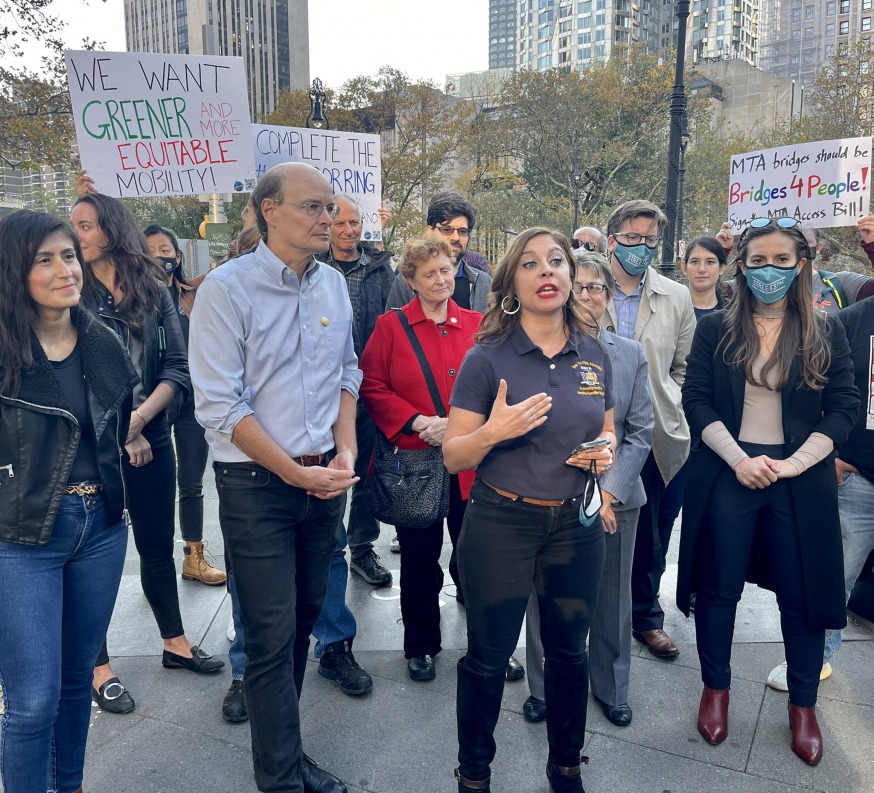
Assembly Member Jessica González-Rojas, Senators Jessica Ramos and Alessandra Biaggi and others call on Gov. Hochul to sign a bill that would require the MTA to prioritize bike and pedestrian access (Assembly Member Jessica González-Rojas)
Nov. 19, 2021 By Allie Griffin
Assembly Member Jessica González-Rojas joined cycling advocates Thursday to call on the governor to sign her bill that would require the MTA to prioritize bicycle access.
González-Rojas and State Sen. Alessandra Biaggi (D-Bronx), who sponsored the bill in the state Senate, gathered with advocates at the foot of the Brooklyn Bridge Thursday to put pressure on Gov. Kathy Hochul to sign their bill into law.
The legislation — which unanimously passed both the Senate and Assembly in June — would require the MTA to develop a strategic plan to promote both bike and pedestrian access on all MTA bridges and commuter rail stations across New York. It also would require the agency to prioritize such access when planning new capital projects.
“For New York to build back better itself we have to center access and equity in infrastructure,” González-Rojas said. “Increasing bike and pedestrian access to MTA bridges are essential to that goal.”
She said the bill is about combating climate change and helping immigrants — such as the many immigrants who work as delivery people.
“This is important for deliveristas trying to do their work and for cyclists who want to sustain their health during a global pandemic,” González-Rojas said. “It’s an immigrant justice issue and an environmental justice imperative.”
Additionally, the legislation calls for extra members — who are experts on bike and pedestrian access — to be added to advisory councils for New York’s transportation systems — including one such new member to the Long Island Rail Road Commuter’s Council, one to the Metro-North Rail Commuter’s Council, and three to the New York City Transit Authority Advisory Council.
If the bill were to become law, the MTA would be required to conduct a report on bike and pedestrian access within the transit system and future projects. The agency would need to submit the report to the governor and state legislature — and make it available online — within one year.
“With nearly 800,000 New Yorkers cycling regularly, we have a responsibility to ensure that our infrastructure is safe, welcoming, and accessible to cyclists and pedestrians,” Biaggi said. “Implementing this bill will allow us to bring our public transportation system into the 21st century while advancing towards our climate goals.”
The organizers cited the city’s decision to remove a car lane and convert it into a bicycle lane on the Brooklyn Bridge as an example of a sustainable and equitable transportation policy that MTA should follow.
“New York continues to experience a bike boom and it is time for the MTA to catch up,” said Juan Restrepo, a Queens-based organizer at Transportation Alternatives. “As we celebrate a new bike lane on the Brooklyn Bridge, the MTA refuses to open access for cyclists and pedestrians on the Verrazzano Bridge and other state-operated bridges.”
Restrepo said signing the bill would be a step towards bringing the MTA up to speed with the needs of New York City.
“For the sake of our climate, our safety, and for commuters across the region, we urge Governor Hochul to sign this bill without delay,” he said.
